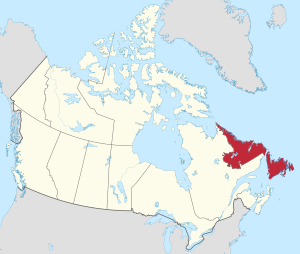
Back Newfoundland en Labrador Afrikaans ኑፈንላንድና ላብረዶር Amharic Niwgefundenland and Labrador ANG نيوفندلاند ولابرادور Arabic ܢܝܘܦܐܘܢܕܠܢܕ ܘܠܐܒܪܐܕܘܪ ARC نيوفاوندلاند و لابرادور ARZ Terranova y Labrador AST न्यूफ़ाउण्डलैण्ड औ लैब्राडोर AWA Nyufaundlend və Labrador Azerbaijani نیوفاندلند و لابرادور AZB
Newfoundland and Labrador
| |
|---|---|
| Motto(s): | |
| Coordinates: 53°13′48″N 59°59′57″W / 53.23000°N 59.99917°W[2] | |
| Country | Canada |
| Before confederation | Dominion of Newfoundland |
| Confederation | March 31, 1949 (12th) |
| Capital (and largest city) | St. John's |
| Largest metro | Greater St. John's |
| Government | |
| • Type | Parliamentary constitutional monarchy |
| • Lieutenant governor | Joan Marie Aylward |
| • Premier | Andrew Furey |
| Legislature | Newfoundland and Labrador House of Assembly |
| Federal representation | Parliament of Canada |
| House seats | 7 of 338 (2.1%) |
| Senate seats | 6 of 105 (5.7%) |
| Area | |
| • Total | 405,212 km2 (156,453 sq mi) |
| • Land | 373,872 km2 (144,353 sq mi) |
| • Water | 31,340 km2 (12,100 sq mi) 7.7% |
| • Rank | 10th |
| 4.1% of Canada | |
| Population (2021) | |
| • Total | 510,550[3] |
| • Estimate (Q3 2024) | 545,247[4] |
| • Rank | 9th |
| • Density | 1.37/km2 (3.5/sq mi) |
| Demonym(s) | Newfoundlander Labradorian (see notes)[a] |
| Official languages | English (de facto)[5] |
| GDP | |
| • Rank | 8th |
| • Total (2011) | C$33.624 billion[6] |
| • Per capita | C$65,556 (5th) |
| HDI | |
| • HDI (2021) | 0.900[7]—Very high (13th) |
| Time zones | |
| Newfoundland | UTC-03:30 (Newfoundland Time Zone) |
| Labrador (Black Tickle and North) | UTC-04:00 (Atlantic Time Zone) |
| Canadian postal abbr. | NL (formerly NF) |
| Postal code prefix | |
| ISO 3166 code | CA-NL |
| Flower | Pitcher plant |
| Tree | Black spruce |
| Bird | Atlantic puffin |
| Rankings include all provinces and territories | |
Newfoundland and Labrador (/ˈnjuːfən(d)lənd, -lænd ... ˈlæbrədɔːr/ NEW-fən(d)-lənd, -land ... LAB-rə-dor, locally /ˌn(j)uːfənˈlænd ... / NEW-fən-LAND ...; French: Terre-Neuve-et-Labrador; frequently abbreviated as NL) is the easternmost province of Canada, in the country's Atlantic region. The province comprises the island of Newfoundland and the continental region of Labrador, having a total size of 405,212 km2 (156,453 sq mi). As of 2024 the population of Newfoundland and Labrador was estimated to be 545,247.[8] The island of Newfoundland (and its smaller neighbouring islands) is home to around 94 per cent of the province's population, with more than half residing in the Avalon Peninsula. Labrador has a land border with both the province of Quebec, as well as a short border with the territory of Nunavut on Killiniq Island. The French overseas collectivity of Saint Pierre and Miquelon lies about 20 km (12 mi) west of the Burin Peninsula.
According to the 2016 census, 97.0% of residents reported English as their native language, making Newfoundland and Labrador Canada's most linguistically homogeneous province. Much of the population is descended from English and Irish settlers, with the majority immigrating from the early 17th century to the late 19th century.[9][10][11] St. John's, the capital and largest city of Newfoundland and Labrador, is Canada's 22nd-largest census metropolitan area and home to about 40% of the province's population. St. John's is the seat of the House of Assembly of Newfoundland and Labrador as well as the province's highest court, the Newfoundland and Labrador Court of Appeal.
Until 1949, the Dominion of Newfoundland was a separate dominion in the British Empire. In 1933, the House of Assembly of the self-governing dominion voted to dissolve itself and to hand over administration of Newfoundland and Labrador to the British-appointed Commission of Government. This followed the suffering caused by the Great Depression and Newfoundland's participation in the First World War. On March 31, 1949, it became the 10th and most recent province to join the Canadian Confederation as "Newfoundland". On December 6, 2001, the Constitution of Canada was amended to change the province's name from "Newfoundland" to "Newfoundland and Labrador".
- ^ "Place names – Terre-Neuve-et-Labrador". Natural Resources Canada. Archived from the original on December 17, 2019. Retrieved November 15, 2021.
- ^ "Newfoundland and Labrador". Geographical Names Data Base. Natural Resources Canada.
- ^ "Population and dwelling counts: Canada, provinces and territories". Statistics Canada. February 9, 2022. Archived from the original on February 9, 2022. Retrieved February 9, 2022.
- ^ "Population estimates, quarterly". Statistics Canada. September 27, 2023. Archived from the original on September 28, 2023. Retrieved September 28, 2023.
- ^ "The Legal Context of Canada's Official Languages". University of Ottawa. Archived from the original on December 21, 2016. Retrieved March 7, 2019.
- ^ "Gross domestic product, expenditure-based, by province and territory (2011)". Statistics Canada. November 19, 2013. Archived from the original on September 19, 2012. Retrieved September 26, 2013.
- ^ "Sub-national HDI". Global Data Lab. Archived from the original on July 18, 2021. Retrieved July 18, 2021.
- ^ Department of Finance (January 1, 2024). "People". Archived from the original on March 29, 2024. Retrieved April 24, 2024.
- ^ Handcock, Gordon. "English". Heritage: Newfoundland and Labrador. Retrieved September 2, 2024.
- ^ Mannion, John. "The Irish in Newfoundland". Heritage: Newfoundland and Labrador. Retrieved September 2, 2024.
- ^ Handcock, Gordon. "The West Country". Heritage: Newfoundland and Labrador. Retrieved September 3, 2024.
Cite error: There are <ref group=lower-alpha> tags or {{efn}} templates on this page, but the references will not show without a {{reflist|group=lower-alpha}} template or {{notelist}} template (see the help page).


